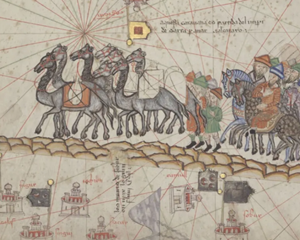Researchers have discovered the remains of medieval cities perched above the ancient Silk Road in the rugged mountains of southeastern Uzbekistan.
在烏茲別克斯坦東南部崎嶇山巒中的古代絲綢之路上,研究人員發現了中世紀城市的遺址。
One of them is a sprawling, high-altitude metropolis that lay hidden for centuries, in a place where few expected to find signs of ancient civilizations.
其中之一是一座向外擴張的高海拔大都市,它已經在此靜默了許多個世紀,鮮少有人預料到能在這片地方發現古代文明的跡象。
The discovery, made possible by new drone-based lidar technology, challenges long-held assumptions about urban life in the remote mountains of Central Asia more than a thousand years ago.
在新型無人機激光雷達技術的支持下,該發現動搖了長期以來考古界有關中亞偏遠山地一千多年前的城市生活的猜想。
The groundbreaking research, led by National Geographic Explorer Michael Frachetti and Farhod Maksudov, director of Uzbekistan's National Center of Archaeology, reveals a bustling city that thrived between the 6th and 11th centuries.
國家地理學會探險家邁克爾·弗拉切蒂和烏茲別克斯坦科學院考古研究所所長馬克蘇多夫·法爾霍德領導了這項突破性的研究,研究發現了一座興盛于6世紀到11世紀之間的繁華都市。
Situated at altitudes reaching up to 7,200 feet (comparable to Machu Picchu in the Peruvian Andes), this discovery sheds new light on the complexity, scale, and elevation of medieval societies along the Silk Road, the vast network of ancient trade routes that connected Europe and Eastern Asia.
它位于7200英尺的海拔高度(與秘魯安第斯山脈上的馬丘比丘相當),為我們了解絲綢之路沿線中世紀社會的復雜程度、規模與海拔高度提供了新的視角,而這些社會構成了巨大的古代貿易路線網,連接著歐洲與東亞。
The ruins of the ancient city of Tugunbulak cover nearly 300 acres, making it one of the largest regional settlements of its time, according to a paper published today in Nature and based on research funded by the National Geographic Society.
根據一項由國家地理學會資助、于10月23日在《自然》期刊發表的研究,圖貢布拉克古城遺址占地近121萬平方米,是同時期最大的人類定居點之一。
"Lidar showed us that there's a massive city there, hiding in plain sight," says Frachetti, associate professor of anthropology at Washington University, St Louis. "It allowed us to approach this huge landscape in a way that lets you appreciate the scope and scale of the place, with stunning detail."
“激光雷達發現,一座大型城市就在眼前平平無奇的風景之下。”在圣路易斯華盛頓大學擔任人類學副教授的弗拉切蒂說,“該技術讓我們在感嘆于其規模之廣、范圍之大的同時,獲取驚人的細節,以這種方式認識這片巨大的景觀。”

About three miles away, a smaller, densely built city called Tashbulak was also surveyed by lidar, a remote sensing method that uses reflected light to create detailed 3-dimensional maps.
大約三英里外,激光雷達技術探測到了一座結構緊湊的更小的城市塔什布拉克。激光雷達是一種遠程探測方法,能利用光的反射創建詳盡的三維地圖。
It's hard to picture cities of this size thriving in a snow-covered, wind-battered environment where even today, only a handful of nomadic herdsmen venture.
你很難想象冰雪覆蓋、強風呼嘯的環境里怎么會發展出如此規模的城市;即使在今天,也只有屈指可數的游牧部落在那里活動。
The long winters, steep cliffs, and rugged terrain made large-scale farming nearly impossible at such high altitude -- a fact that may explain why historians and archaeologists mostly overlooked this remote region for so long.
漫長的冬季、陡峭的山崖以及崎嶇的地形都使得大規模農業幾乎無法在如此海拔高度實現,這一事實也許能解釋為什么在過去那么長時間里,歷史學家與考古學家大多忽略了這個偏僻的地域。
But Frachetti's team believes these highland urban centers weren't just surviving, they were thriving—in ways that defy expectations of what medieval mountain societies were capable of.
但弗拉切蒂團隊認為,這些高地上的城市中心那時并不是在艱難圖存,而是在蓬勃發展,其繁榮的方式打破了學界對中世紀高山社會的可能性的想象。
Both Tashbulak and Tugunbulak feature multiple permanent structures and sophisticated urban designs, seemingly crafted to make the most of the mountainous terrain.
塔什布拉克與圖貢布拉克兩座古城都有多樣的永久性建筑和精妙復雜的城市設計,它們的建造似乎都是為了最大化利用山區地形。
The high-resolution lidar images offer detailed views of the houses, plazas, fortifications, and roads that shaped the lives and economies of these highland communities.
高分辨率的激光雷達圖像提供了房屋、廣場、防御工事和道路的詳細視圖,這些結構塑造了高地社區的生活與經濟。
The larger of the two, Tugunbulak, boasts five watchtowers linked by walls along the ridgelines, as well as a central fortress protected by thick stone and mud-brick walls.
兩城中更大的圖貢布拉克擁有五座由城墻連接、沿山脊分布的暸望塔,還有一座在石頭與泥磚保護下的中央堡壘。












